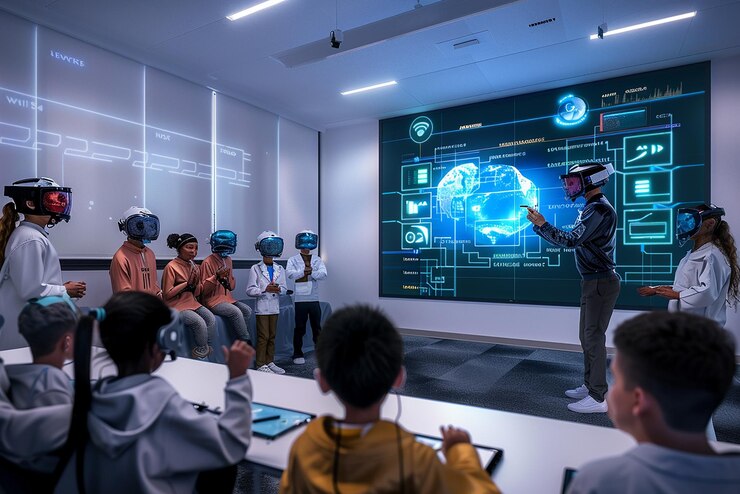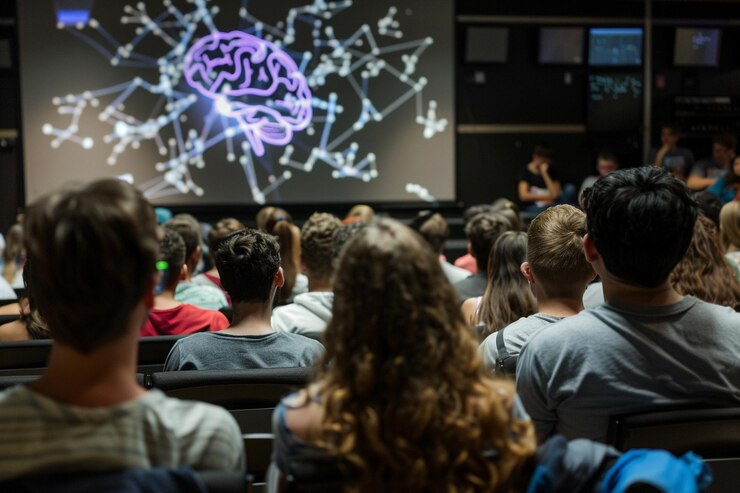Table of Contents
Introduction
AI in Education Presentation The Importance of Artificial Intelligence in Education and Powerful Presentation Techniques
Education is not an exception to the ways artificial intelligence (AI) is transforming numerous industries. AI-powered resources are changing the way teachers and students learn in the classroom as they are included more and more. Artificial Intelligence is offering solutions to improve educational experiences and outcomes, ranging from automated grading systems to tailored learning paths. For educators, students, and decision-makers who want to stay ahead in this changing world, it is imperative that they understand how AI is transforming education.
Your audience can learn and be motivated by your presentation on AI in education. In addition to educating, a presentation with a clear framework also engages and piques interest. It offers a chance to investigate the advantages, difficulties, and potential applications of AI in educational contexts. Effectively communicating the potential of artificial intelligence (AI) in education will assist your audience in appreciating the need of adopting this technological innovation, regardless of whether you are speaking to educators, students, or tech enthusiasts.
AI in Education Presentation This guide’s primary goal is to give you useful advice and techniques for giving an impactful AI presentation in the classroom. This tutorial covers key strategies to increase the impact of your presentation, from interactive components and ethical issues to visual storytelling and real-world examples. Learning these techniques can help you explain intricate AI ideas in a clear and engaging manner.
AI in Education Presentation In the parts that follow, we’ll look at how to organize your talk, break down complex AI subjects for your audience, captivate them with interactive material, and leave a lasting impression by outlining our vision for the application of AI in education. These techniques will provide you the tools you need to give a presentation that inspires and stimulates thought-provoking discussions on the direction of education.
The Significance of AI in Education

AI
AI in Education Presentation presents creative answers to some of the most critical problems facing learning settings, and it is quickly changing education. AI has a significant impact on education because it may improve learning and teaching processes, making them more accessible, individualized, and effective. AI has a significant and wide-ranging impact on education, from personalized learning pathways to AI-driven administrative support.
Personalized learning is among the most important ways artificial intelligence has improved education. AI-driven systems examine student data to identify learning trends, areas of strength, and areas for improvement. Customized learning pathways that are suited to the requirements of every student can be created thanks to this data-driven approach. To guarantee that students receive the appropriate amount of challenge or support, tools such as adaptive learning software modify the way content is delivered in real time based on the performance of the students. It was previously not possible to achieve this level of personalization in typical classrooms using standardized teaching approaches.
AI is simplifying administrative duties in educational institutions in addition to enabling personalized learning. Artificial intelligence (AI) applications can automate tasks such as scheduling, attendance tracking, and grading, giving teachers more time to concentrate on teaching and student engagement. AI-powered grading systems, for instance, may assess assignments and deliver comments right away, enhancing students’ overall learning experiences while lightening teachers’ workloads.
Additionally gaining traction is the incorporation of AI into international educational institutions. Globally, educational institutions are implementing AI in Education Presentation technologies to optimize the classroom environment, boost student achievement, and streamline administrative workflows. Governments and academic institutions are realizing more and more how AI can close educational gaps, give students access to high-quality learning materials, and get them ready for a digital future.
AI has the ability to completely transform education, and as it develops, its importance in education will only increase. Therefore, it is crucial that educators, decision-makers, and students recognize this and embrace AI’s revolutionary potential.
Getting Ready to Present on AI in Education
A presentation on artificial intelligence in education needs to be carefully planned and take into account a number of important issues. The planning stage lays the groundwork for presenting an interesting and educational presentation, from knowing your audience to establishing clear objectives.
Recognise Your Audience:
The first thing to do is to decide who you will be speaking to. Do these teachers want to incorporate AI into their lessons? Are students interested in the part AI plays in their education? Or legislators curious about the wider effects of AI in education? It’s critical to adjust your presentation to the requirements and preferences of your audience. For educators, concentrate on using AI in the classroom in useful ways. Stress to kids how AI may improve their educational experiences. Emphasize to legislators how AI can promote structural changes and provide fair access to high-quality AI in Education Presentation.
Establish Clear Objectives and Takeaways:
Prior to creating any material, it’s critical to decide on the main goals and objectives for your presentation. After your presentation, consider what you would like the audience to know, feel, or accomplish. Do you want to educate them on the newest artificial intelligence tools for teaching? Or do you support the use of AI in Education Presentation-powered solutions? Identify the main points you want your audience to remember. For example, you may want them to comprehend the ethical issues surrounding the use of AI in education or the advantages of individualized learning using the technology.
Organize Your Presentation:
A well-structured presentation leads the audience through the main ideas you want them to hear. Set the scene with an interesting introduction that emphasizes the importance of AI in education. Your main information should be arranged into areas that make sense, like future trends, useful applications, and the advantages of AI. To further bolster your arguments, use examples from everyday life and visual aids. Finish with a compelling conclusion that encapsulates the main ideas and provides your audience with next steps or provocative questions.
By considering these factors in advance, you can make sure that your presentation on AI in education is not only thorough but also powerful, leaving a long-lasting effect on your audience

A
Using Images to Simplify Complex AI Concepts
AI in Education Presentation) ideas can be complex and daunting, particularly for audiences that are not tech-savvy. Here’s when the importance of visual narrative kicks in. Complex concepts can be simplified and made more readable by using visual aids like charts, infographics, and diagrams. Using visual aids can help your audience understand complex ideas more quickly and remember them for longer. Visuals are essential for improving understanding, whether you’re presenting data on AI-driven educational results or describing how machine learning algorithms operate.
For More Information Click Here
Resources for Producing Powerful Images
You need the correct tools in order to produce visually appealing content. Sites such as Canva, Piktochart, and Venngage provide easy-to-use interfaces with pre-made templates for infographics and data visualizations. You may easily produce compelling material with programs like Animaker, Vyond, and Blender if you’re trying to add animations that can convey AI ideas in a dynamic way. Adobe Illustrator and After Effects are great for creating high-quality graphics and animations, but they are also great for more complex and adaptable visuals. You can use these tools to turn esoteric concepts or complicated facts into visually stunning narratives that enthrall your audience.
AI Presentations, Some Instances of Effective Visual Storytelling
A strong AI in Education Presentation presentation strikes a mix between visual appeal and technical depth. For example, you may give an infographic that contrasts conventional teaching methods with AI-enhanced ones, rather than just raw data on AI in Education Presentation impact on education. An animated clip that illustrates how an AI-driven adaptive learning system modifies content in response to student performance could serve as another example. Real-world application visualizations, such those showing AI in automatic grading or tailored learning, aid in bridging the gap between abstract technology and useful application. You may captivate and clearly lead your audience through complex topics by carefully selecting pictures that support your story.
Visual storytelling is a potent tool for making your AI presentation memorable and educational, keeping your audience interested and ensuring they take away a firm grasp of the ideas covered.
Including Real-World Examples to Show AI’s Effect on Education
Useful AI Case Studies in Education
When the practical applications of AI in Education Presentation are investigated through real-world use cases, the function of AI in education becomes more evident. Adaptive learning platforms are among the most well-known examples. DreamBox and Smart Sparrow are two examples of AI-driven systems that customize content delivery based on each student’s performance. They guarantee individualized and successful learning experiences by continually evaluating a learner’s progress and dynamically adjusting classes to match their level.
AI in Education Presentation-driven tutoring programs, such as MATHia from Carnegie Learning, are another important application. These platforms act as online tutors, giving students immediate feedback, responding to their questions, and helping them work through challenging assignments. AI tutoring systems, in contrast to traditional tutoring, are always available and provide students in need of individualized attention with scalable help. This has been especially helpful in closing the learning gaps in disciplines like physics and math.
Information and Figures on the Effect of AI on Education
Data that shows enhanced learning outcomes and efficiency demonstrate the use of AI in Education Presentation in education. According to studies, students who use adaptive learning platforms typically learn 30% more quickly than those who study in traditional settings. Significant gains in student performance have also been shown by AI tutoring systems; on some platforms, subject knowledge has increased by up to 50%.
AI in Education Presentation is also showing its worth in administrative positions. Up to 20% less manual labor is reported by schools using AI for administrative duties, giving teachers more time to concentrate on instruction. These numbers demonstrate how artificial intelligence (AI in Education Presentation) is a useful technology with quantifiable advantages rather than merely a theoretical breakthrough.
Increasing Relevance using Practical Examples
Your presentation will be more relatable and engaging if you use these real-world examples. Audiences are more able to understand the importance of AI in education when they witness observable results, such as increased student engagement, better learning efficiency, and lighter workloads for teachers. By showcasing use cases that are supported by data, you can make your presentation more persuasive and educational while also highlighting the usefulness of AI in Education Presentation.
Increasing Interaction with Interactive Components
Delivering a presentation with effect requires interaction, particularly when talking about complicated subjects like artificial intelligence in education. By including interactive aspects, you may maintain audience interest, promote engagement, and reaffirm important lessons learned. The following are some useful tactics to increase audience participation in your presentation on AI in education.
For More Information Click Here
Making Use of Real-Time Feedback Tools, Q&A Sessions, and Live Polls
Using live polls, Q&A sessions, and real-time feedback is one of the finest methods to make your presentation more interesting. You can use live polls to find out what your audience thinks, to get insights, or to see how well-informed they are on a given subject. You may, for example, find out what your audience believes will be the biggest effect of AI in Education Presentation. Your conversation can be steered and the meeting can become more lively with the immediate comments.
An additional effective interactive tool is Q&A sessions. By allowing questions from the audience either during or after your presentation, you may allay concerns and create a more conversational and engaging presentation. Furthermore, you can gather audience input on the precision, applicability, or efficacy of your presentation using real-time feedback tools, which will enable you to make immediate adjustments and improvements.
Resources to Include Interactive Elements in Your Presentation
A variety of digital tools are at your disposal to assist you in smoothly incorporating interactivity into your presentation. You can make live polls, quizzes, and interactive presentations using tools like Mentimeter, Slido, and Poll Everywhere. These resources improve audience participation while simultaneously simplifying difficult topics. Another way to incorporate gamified components into your presentation and make learning enjoyable and competitive is with Kahoot.
The Function of Audience Engagement in Consolidating Essential Ideas
In addition to being essential for maintaining focus, audience engagement helps to emphasize your main ideas. The likelihood that an audience will internalize and retain the information increases when they actively participate in conversations, polls, and ask questions. Interactive components serve to solidify the content in the audience’s memory by offering instantaneous feedback and validation. Involving the audience also fosters a more welcoming atmosphere, which enhances the educational and memorable aspects of your presentation.
Taking Ethical Aspects into Account in AI
AI-Related Ethics Issues in Education

It is imperative to address ethical issues as AI in Education Presentation is incorporated into educational settings more and more. Bias in AI systems is a significant worry. Inadequately constructed AI systems have the potential to reinforce or even magnify preexisting prejudices. Algorithms employed for admissions or grading, for example, may give preference to some demographic groups over others, producing unfair results. Privacy is another important concern. AI in Education Presentation systems frequently gather and examine enormous volumes of student personal data, which raises questions about data security and the possible exploitation of private information.
How to Include Ethical Issues in Your Presentation
In order to offer a fair assessment of AI in Education Presentation effects, it is imperative that these ethical concerns be highlighted in presentations on AI in education. Begin by describing how faulty algorithms or biased training data might cause biases in AI in Education Presentation in Education Presentation systems. Give instances of how AI in Education Presentation bias has impacted educational achievements using real-world situations. In a similar vein, talk about privacy issues by describing how AI in Education Presentation technologies handle student data and the safeguards in place. You can demonstrate that you’ve thought through the ramifications of AI and give your presentation more depth by including case studies or expert comments on these subjects.
Promoting Critical Thought and Conversation
Inspiring your audience to reflect on the moral implications of artificial intelligence is essential. Ask open-ended questions concerning the advantages and disadvantages of artificial intelligence (AI in Education Presentation) in the classroom to foster critical thinking. For instance, find out from your audience what steps they would take to overcome prejudice in AI in Education Presentationsystems or what measures ought to be put in place to protect students’ privacy. Encourage conversations that delve into different viewpoints and approaches. This method not only enhances the discussion but also aids in your audience’s comprehension of the difficulties involved in ethically incorporating AI into education. Thoughtfully addressing ethical issues will boost the credibility of your presentation and add to a better educated conversation on the application of AI in Education Presentation.
Final Thoughts on Upcoming Trends
New Developments in AI and How They Affect Education
Artificial intelligence is a field that is always changing, and educational applications are no different. New developments in AI have the potential to drastically alter the educational landscape. The advancement of sophisticated natural language processing (NLP) technologies, which help AI systems comprehend and communicate with human language more effectively, is one notable trend. This may result in increasingly advanced AI instructional assistants and tutors that offer real-time, individualized support and feedback.
The emergence of AI in Education Presentation-powered virtual and augmented reality (VR/AR) applications is another trend. These technological advancements produce immersive learning environments that raise comprehension and engagement levels in students. For instance, virtual reality (VR) can replicate historical occurrences or scientific phenomena, giving students access to previously unattainable first-hand experiences. AR enables contextual and interactive learning by superimposing interactive features on real-world items.
Future Projections for Artificial Intelligence in Education
In the future, artificial intelligence is anticipated to become even more crucial to education. With more refinement, predictive analytics will enable teachers to more precisely predict students’ needs and performance. As a result, proactive interventions and individualized learning plans that are catered to the changing needs of each student will be possible.
Additionally, AI will help collaborative learning environments more and more. AI-powered tools that support peer-to-peer interactions and group projects will develop the teamwork and communication skills necessary for today’s workforce. Furthermore, AI will play a bigger part in resolving educational disparities as AI in Education Presentation-driven platforms offer scalable ways to connect with marginalized communities and give everyone access to high-quality education.
Call to Action: Keep Up with AI Developments and Stay Informed
It is critical that educators, students, and legislators keep up with the latest advancements in artificial intelligence. Take advantage of continuing education options to learn how AI in Education Presentation can be successfully incorporated into teaching methods. Participate in workshops centered on AI in Education Presentation, go to conferences, and interact with professional networks. You may help shape education’s future and fully utilize AI in Education Presentation to improve learning outcomes for everyone by keeping up to date and becoming involved.
Conclusion:
We discussed how AI is revolutionising education in this lecture. We talked about how AI in Education Presentationis transforming personalised learning by creating adaptive learning environments that adjust to the unique demands of each student. We also emphasised how AI streamlines administrative duties like scheduling and grading, freeing up teachers to concentrate more on instruction. We also looked at the worldwide trend of AI integration in educational systems, highlighting how important it is becoming everywhere.
It’s essential to comprehend and use AI in education if you want to improve learning outcomes and get pupils ready for the future. AI’s importance in contemporary education is highlighted by its capacity to deliver scalable solutions, optimise administrative procedures, and personalise learning experiences. Educators and institutions may establish more inclusive, productive, and engaging learning environments by incorporating AI in Education Presentation.
The use of AI in Education Presentation will only grow in the future, presenting fresh chances to improve instruction and student outcomes. Let’s continue to be receptive to these developments and proactive in using AI tools that support equity and excellence in education. The promise of a better, more connected, and more informed future for students worldwide is inherent in the early stages of AI’s voyage into education.
Common Questions About AI in Educational Presentations are Addressed in the FAQ Section
Q1: How should a difficult AI topic be simplified for an educational presentation?
A: To simplify difficult subjects, use visual aids like infographics, graphs, and animations. To make the material more approachable, simplify the language and make use of real-world analogies.
Q2: What are the suggested resources for producing impactful visuals for an AI in education presentation?
A variety of tools, including Adobe Spark, Prezi, and Canva, are great for producing visually appealing material. Use Google Slides or Powtoon for interactive components and animations.
Q3: How can I enhance the interactivity of my AI-based educational presentation?
A: Use interactive components to engage your audience and get feedback in real time, such as live polls, Q&A sessions, and quizzes utilising Mentimeter, Slido, or Kahoot.
Q4: When introducing AI in education, what are some typical technical obstacles that I may encounter and how can I overcome them?
A: Common problems include internet connectivity problems, incompatible software, and technological malfunctions. Make sure you have offline copies of your materials, test your presenting equipment in advance, and have backup plans ready.
Q5: How can I make sure a non-technical audience finds my presentation on AI in education interesting?
A: Pay less attention to intricate technical intricacies and more attention to the useful advantages and real-world uses of AI in Education Presentation in Education Presentation. Tell tales, present case studies, and provide examples to demonstrate how AI improves teaching.
Q6: What is the ideal duration for an AI presentation in education?
Aim for between thirty and sixty minutes, taking into account the audience’s level of involvement and the depth of the information. Make sure to set some time for interactive exercises and Q&A.
Q7: What are some important ethical points to cover in a presentation on artificial intelligence in education?
A: Talk about issues like data privacy, possible biases in AI systems, and the moral application ofAI in Education Presentation-making. Talking about these problems can help people grasp AI’s place in education on a broader level.
Q8: How can I effectively communicate study findings and statistical data about artificial intelligence in the classroom?
A: To exhibit statistical data, use easy-to-read graphs, charts, and data visualisations. Make sure the information you have is current and pertinent to your audience. Give your viewers some context so they can better understand the results.
Q9: What techniques can I employ to maintain audience interest during my presentation?
A: Mix up your lectures with multimedia, storytelling, and interactive sections to provide a variety of presenting styles. To keep audiences interested, promote audience engagement and keep the pacing lively.
Q10: How can I assess whether my AI-based educational presentation was successful?
A: Use post-presentation surveys to collect feedback, examine engagement measures (such as polling and Q&A participation) to gauge audience interest, and gauge comprehension levels using follow-up tests or conversations.






